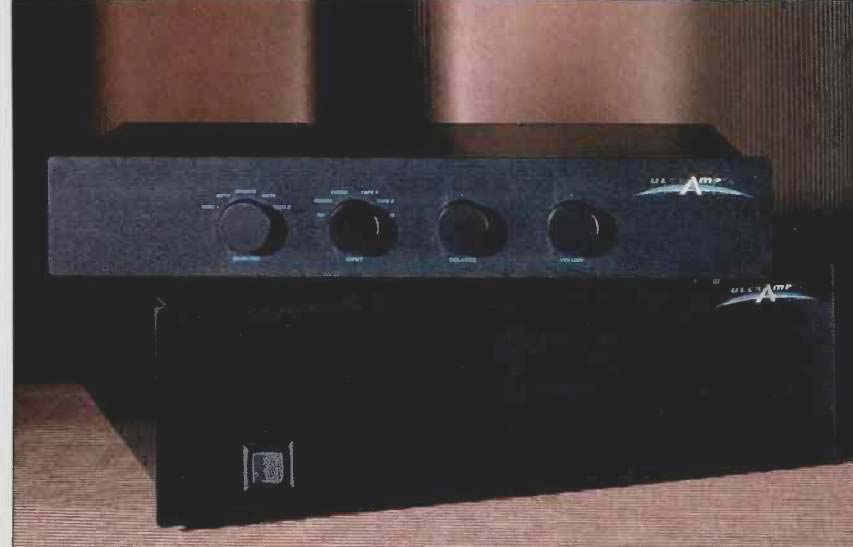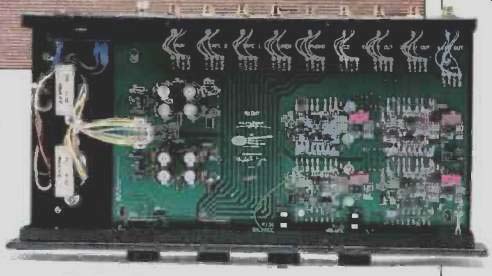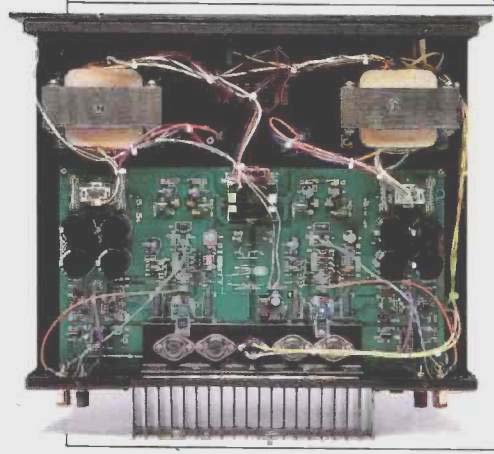
Company Address: 105 Morris St., Sebastopol, Cal. 95472.
The UltrAmp Line Amplifier and UltrAmp Power Amplifier are part of a new series of components from Mobile Fidelity Sound Lab, long a source of top-quality recordings. The units are hand assembled in the U.S. and tested by designer Michael Yee. The UltrAmp product marketing is unusual; the equipment is being sold directly to the consumer by the manufacturer. Mobile Fidelity offers the buyer a 30-day, in-home audition, technical support through toll-free phone lines, and a comprehensive three-year warranty.


The UltrAmp line features fully discrete amplification circuitry (no integrated op-amps) and dual mono design with separate power transformers (not just separate windings) for each channel. Rather than trying to maximize the usual specs, Mobile Fidelity has taken a psychoacoustic approach to these designs, stating that their re search shows that sonic differences between amps are mostly due to distortion components that fall below the noise floor. Feedback is limited to a moderate 30 dB or so; slew rate is 2.5 V/uS, which the company says is adequate because it is 10 times the maxi mum slew rate in music. Bandwidth is 2 Hz to 200 kHz.
Direct marketing does offer some significant potential savings to the consumer, as dealers get a margin of about 30 to 50 points on high-end electronics. The UltrAmp Line Amplifier and Power Amplifier sell for $1,295 each. This is not an inconsiderable price, even by high-end standards. At this price point, there is a great deal of demanding competition from a wide range of high-end firms, including such well-established names as Adcom, B & K Components, Counterpoint, Forte Audio, Hafler, PS Audio, and VTL. And if you compare it to products priced as the UltrAmp line would be after a dealer markup, well over $1,500 each, the competition becomes even more demanding.
The UltrAmp preamplifier has relatively simple features: A selector for six line-level inputs, a combination muting and tape monitor switch with positions for two tape decks, and controls for volume and balance. It does, however, have sophisticated electronics. Each channel of this dual mono design has a separate line stage plus a separate buffer stage for tape outputs to ensure that interconnect cables and tape recorder inputs do not interact with the source. The preamp does not include a phono gain stage, but one is available from the manufacturer at extra cost.
The UltrAmp preamp has double regulation on the power supplies, separate ground planes for each channel, and a direct signal path without a.c. coupling capacitors; it uses conductive plastic potentiometers and silver plated high-conductivity switches. Total harmonic distortion is rated at less than 0.02%, signal-to-noise ratio at 90 dB, and gain at 12 dB. The input impedance is 10 kilohms, and the output impedance is 100 ohms.
The UltrAmp Line Amplifier has a perfectly acceptable exterior style and finish, although I personally don't care for either the legibility or style of the blue lettering for the control functions.
The unit does, however, have well-built input and output jacks and clean, well laid-out circuit boards with high-quality components. The front panel is thick and exceptionally strong, and the power supply seems to be very well constructed.
I received two samples of the pre amplifier. The earlier sample sounded far less clean than the second, the dot on its balance control was not aligned to show proper channel balance, and the volume control's lowest setting did not produce total silence. The second unit not only had superior sound but a properly aligned balance control. It still, however, would not produce total silence with the volume control at its minimum position.
The second sample of the UltrAmp Line Amplifier provided an open, de tailed, and dynamic sound. Overall frequency response and timbre were good, bass was very good, and the midrange and treble were detailed and extended. The soundstage was nicely detailed, with very good imaging and width, although depth and the ability to resolve layers of depth rated only good. Dynamics were very good, superior to those of a number of competing line-stage preamps.
In terms of overall performance, the UltrAmp Line Amplifier was certainly capable of good high-end performance. At the same time, it did not stand out from other products in its price class because it was less transparent and slightly less musically convincing in the upper octaves.
The UltrAmp Power Amplifier has an output power of 100 watts per channel into 8 ohms and 150 watts into 4 ohms, and a maximum current output of 20 amperes. Mobile Fidelity feels that conventionally designed speakers of 4 ohms or higher impedance never need current higher than 10 amperes. Total harmonic distortion is rated at less than 0.02%, signal-to-noise ratio is 90 dB, and gain is 30 dB.
Like the Line Amplifier, the UltrAmp Power Amplifier has a number of interesting technical features. The amplifier uses three power transformers. Two separate amplifiers are used for the high-current stage of each channel to improve imaging. A third transformer, which has a separate winding for each channel, drives the independently regulated power supplies for the gain stages. Mobile Fidelity feels that using three transformers to separate the high-current functions from the gain functions improves both imaging and apparent power level.
The circuit topology is unusual and does not require a decoupling net work. For an amplifier to use feedback, one stage must be slower than the rest of the stages. In most amplifiers, this "slow stage" is the first stage, in order to improve measured speed. Mobile Fidelity claims that the measured improvement is obtained at the cost of stability with complex speaker loads.
As a result, "fast" amplifiers then re quire decoupling networks that limit their ability to accurately drive speakers. Mobile Fidelity makes the UltrAmp's last gain stage the slow stage, so that the amplifier becomes more stable under a complex load and can deliver more electrical signal directly to the load.
All this care and effort translate into good sound quality. The UltrAmp Power Amplifier performed well with the Spendor BC-1, Thiel CS3.6, and Quad ESL-63 as well as with more conventional speaker loads. Bass, while not particularly dynamic, was well con trolled and well defined. Midrange performance was well balanced, and transients were quick and well defined.
Imaging was good to very good, as was depth. Soundstage width was moderate. The upper midrange was very clearly defined, although some competing products provide equal information in a more musical or transparent way. Treble performance was good.
Like the UltrAmp Line Amplifier, the UltrAmp Power Amplifier was capable of good high-end performance. At the same time, it too did not stand out from other products in its price class. In deed, some competing products provide a more convincing overall illusion of musical reality. This is particularly true regarding the dynamics and energy of the bass and lower midrange and the sweetness and air of the upper midrange.
It is easily possible to build a good high-end system around the UltrAmp amp and preamp. Today's high-end and mid-fi electronics set a very high standard, however, and well-designed high-end electronics are available at prices as low as $300 for a preamp and $400 for an amp of nearly equal output as the UltrAmp. Any product line that emphasizes price, a special marketing approach, and outstanding value really ought to perform exceptionally well at its price point; I am not sure that the UltrAmps fully meet that test. UltrAmp is certainly a very promising new line, but it may well take some further evolution to surpass its competition.
-Anthony H. Cordesman
(adapted from Audio magazine, Dec. 1992)
Also see:
McLaren 402 Preamp and 702 Amp (Dec. 1986)
Naim Audio NAP 135 Mono Amp and NAC 72 Preamp (Mar. 1992)
= = = =